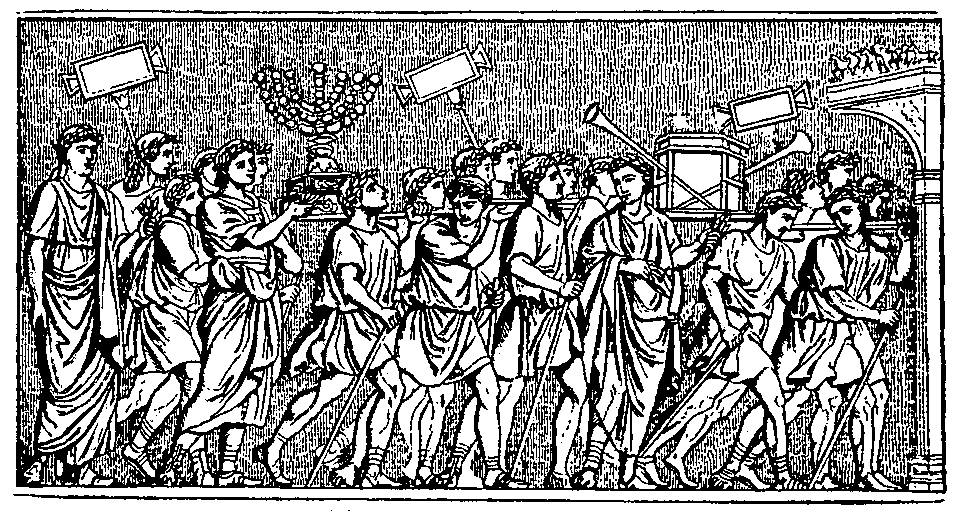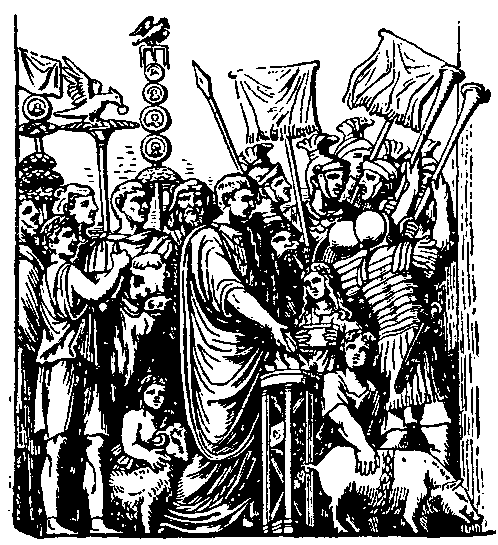| The Roman festal procession at the head of a victorious host through the city to the Capitol, the highest distinction which could be accorded to a victorious commander. Only the regular holder of the highest command (imperium), a dictator, consul, or praetor, was entitled to this honour, and that too even when the decisive victory had not been fought under his immediate direction. It was also essential that the victory should be an important one gained in a regular war; i.e. not against citizens or rebellious slaves. Permission to celebrate a triumph was granted, with the necessary expenses, by the Senate. Up to the day of the triumph, the general was obliged to remain before the city, because his command expired at the moment he entered it. Accordingly it was outside the city, generally in the temple of Bellona, that the Senate assembled to receive his report. On the day of the triumph, the procession, starting from the Campus Martius, proceeded through the Porta Triumphalis into the Circus Flaminius; then, after entering the city through the Porta Carmentalis, it marched on into the Circus Maximus, and thence to the Via Sacra, and up this across the Forum to the Capitol (see plan under FORUM). The streets were adorned with garlands, the temples opened, and, as the procession passed by, the spectators greeted it with the acclamation, Io triumphe! The procession was headed by the State officials and the Senate. Then followed trumpeters, and after them the captured spoils (see fig. 1); next came painted representations of the conquered country, models of the captured fortresses, ships, etc., either carried on men's shoulders or placed in chariots; then the crowns of honour dedicated to the triumphant general by the towns of the province, originally of bay leaves, later of gold. Then the white bulls intended for sacrifice on the Capitol, with gilded horns, decorated with ribands and garlands, and accompanied by youths and boys in holiday attire, carrying gold and silver chalices. Then followed in chains the distinguished captives who had been spared for the triumph, and whose fate it was, when the triumphal car reached the slope of the Capitol, to be dragged off to prison, there almost invariably to meet with immediate execution. Behind these followed the lictors of the general in purple tunics, with their fasces wreathed in bay leaves; then a body of musicians playing on the lyre, and priests with censers; and lastly the triumphal car, gilded, and garlanded with bay leaves, and drawn by four white horses, which were also wreathed with garlands. On it stood the general; in earlier times his body was dyed with vermilion [Pliny, N. H. xxxiii 111]. His head was wreathed with bay, and he wore the garb of the Capitoline Jupiter, furnished him from the treasury of the Capitoline temple; viz. a purple tunic embroidered with golden palm-shoots (tunica palmata), a toga decorated with golden stars on a purple ground (toga picta), gilded shoes, and an ivory sceptre in his left hand, with an eagle on the top; in his right he carried a branch of bay. Over his head a public slave, standing behind >>>>> 656 TRIUMPHAL ARCHES. him, held the golden crown of Jupiter, and, while the people shouted acclama- tions, called to him, "Look behind you, and remember you are mortal." [Tertullian, Apol. 33.] He also guarded himself against envy and the evil eye by an amulet which he wore either on his person or tied to the car. With him on the car, and some- times on the horses, sat his youngest chil- dren, while his grown up sons rode behind with his lieutenants and officers. The soldiers brought up the rear, all wearing decorations, and shouting Io triumphe! In accordance with ancient custom, they also alternately sang songs in praise of their general, and uttered ribald jests at his expense. On arriving at the temple of Capitoline Jupiter, the general, as a token of his victory, placed on the lap of the god the bay leaves wreathed around the fasces, together with his own branch of bay, or (in later times) a palm-branch, the fasces, and his laurel-shoot. He then offered the sacrifice of thanksgiving (cp. fig. 2). The festival, originally limited to one day, gradually extended itself to several. It concluded with a banquet to the State officials and the Senate, and sometimes also with an entertainment for the soldiers and people. If the permission to celebrate the ordinary triumph were refused to a general, he could undertake one on his own account to the temple of Jupiter Latiaris on the Alban Hill. If the conqueror had not fought under his own auspices, or if his exploits did not appear to merit the highest form of triumph, he was allowed to hold one of an inferior kind called an ovatio. In this the conqueror entered the town either on foot (as in earlier times) or on horseback, clad in the toga proetexta, and with a wreath of myrtle on his brow. Under the Empire, only the emperors triumphed, because the generals commanded as their lieutenants (legati Augusti), under the auspices of the emperors, and not under their own. Victorious generals were then obliged to content themselves with the ornamenta triumphalia; i.e. the right of appearing on holiday occasions in the insignia of triumph, the tunica palmata, or toga picta, and wreath of bay leaves. After Trajan's time, even this kind of military distinction ceased, as all consuls were permitted to wear the triumphal deco- rations during festal processions. |

